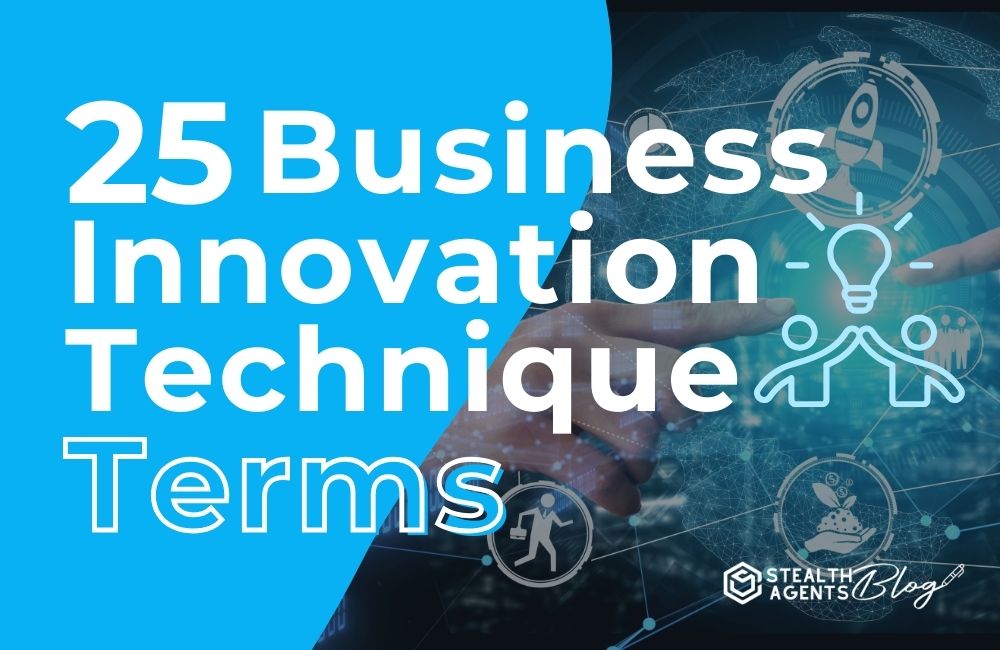Businesses are always seeking fresh approaches to stay one step ahead of their competitors and offer their clients special value.
Businesses must be conversant with several innovation approaches and tactics to accomplish this.
This post will cover 25 phrases related to business innovation techniques that every professional in the field and entrepreneur should know.
These phrases cover product development, customer experience, team management, and other subjects in great detail.
What are innovation business terms?
Innovation terms refer to the specialized vocabulary used in the business world to describe innovative practices, strategies, and techniques.
These terms are constantly evolving as new ideas and technologies emerge, making it important for businesses to stay updated on the latest terminology in order to remain competitive.
Business Innovation Technique Terms
1. Design Thinking
A human-centric approach to innovation that integrates the needs of people, the possibilities of technology, and the requirements for business success.
2. Blue Ocean Strategy
A marketing theory that suggests businesses are better off searching for ways to create uncontested market space (Blue Oceans) than competing in blood-red waters (Red Oceans).
3. Minimum Viable Product (MVP)
The simplest version of a product that can be put in the market to test the hypothesis.
4. Crowdsourcing
The process of getting ideas, services, or content by soliciting contributions from a large group of people, and especially from the online community, rather than from traditional employees or suppliers.
*advertisement*
Tired & Overwhelmed With Administrative Tasks?
Hire A Top 1% Virtual Assistant From Stealth Agents!

Sign Up Below & Hire A Top 1% Virtual Assistant
Rated 4.7 Stars Serving Over 2,000+ Customers.
Hire Top 1% Virtual Assistants For $10-$15 Per Hour
Ask About Our 14 Day Trial!
*advertisement*
5. Lean Startup
A methodology that strives to increase efficiency in a company by minimizing waste and refining products quickly through continuous development.
6. Intrapreneurship
A system where employees are empowered to act as entrepreneurs within the organization, instilling a culture of innovation from the inside-out.
7. Open Innovation
The practice of soliciting ideas and guidance from individuals outside of the company to promote diverse thinking and faster innovation.
8. Idea Sprint
A time-constrained, action-oriented process to answer critical business questions through design, prototyping, and testing ideas with customers.
9. Pivot
A shift in strategy without a change in vision, to respond to new information or to changing market conditions.
10. Disruptive Innovation
A term used to describe an innovation that changes an existing market and propels a new one, typically displacing established market leaders.
11. Business Model Canvas
A strategic management template for developing new or documenting existing business models.
12. Six Sigma
A set of techniques and tools for process improvement, focusing on reducing or eliminating defects.
13. SWOT Analysis
An examination of a company’s internal strengths and weaknesses, along with external opportunities and threats, to create strategic plans.
14. Kanban
A system that controls the logistical chain from a production point of view, and is intended to regulate the on-time delivery of components.
15. Agile Methodology
A system of project management that is characterized by the division of tasks into short phases of work and frequent reassessment and adaptation of plans.
16. Platform Thinking
The process of designing business models that allow multiple participants (producers and consumers) to connect to create and exchange value.
17. Digital Twin
A digital replica of a physical entity or system that helps to monitor, simulate, and analyze data for real-time intervention or future planning.
18. Value Proposition Canvas
A business tool that helps you to understand your customers and the value that your company’s products or services bring to them.
18. Scrum
A framework within which people can address complex adaptive problems, while productively and creatively delivering high-value products.
20. Rapid Prototyping
A group of techniques used to quickly fabricate a scale model of a product using three-dimensional computer-aided design data.
21. Business Ecosystem
The network of organizations—including suppliers, distributors, customers, competitors, government agencies—that are involved in the delivery of a specific product or service.
22. Business Process Reengineering (BPR)
The analysis and design of workflows and processes within an organization, with the goal of making them more efficient and more capable of adapting to an ever-changing environment.
24. Scenario Planning
A strategic planning method that organizations use to make flexible long-term plans. It’s a way for organizations to consider how different scenarios might arise and plan for the response to each.
25. Value Stream Mapping
A lean manufacturing or lean enterprise technique used to document, analyze, and improve the flow of materials or information required to produce a product or service for a customer.
26. The Four Steps To The Epiphany
A book and strategy for developing successful startups and launching disruptive new products.
What are the 4 types of innovation strategies?
1. Product Innovation
The main objective of this kind of innovation strategy is to create and launch new or enhanced items into the market.
It can involve creating entirely new products or improving existing ones through technological advancements, design changes, or added features.
2. Process Innovation
Process innovation involves finding more efficient ways to produce goods or deliver services.
This could include streamlining processes, integrating technology, or implementing new procedures to increase productivity and reduce costs.
3. Business Model Innovation
Business model innovation refers to making significant changes in the way a company operates and generates revenue.
It can involve exploring new markets, diversifying products/services, or changing pricing strategies to stay competitive.
4. Service Innovation
Service innovation focuses on improving the delivery and customer experience of a company’s services.
This could include developing new service offerings, enhancing existing ones, or implementing new technologies to improve the overall customer journey.
Takeaways
Now, armed with these terms, you’re ready to chart a course toward an innovative future.
Remember, innovation isn’t just about doing something new; it’s about doing something different in a way that brings value to your business and the world around it.
Dive into these techniques, integrate them into your lexicon, and watch how they transform not just your operations but also your mindset.
Your business journey is about to get a whole lot more innovative!










